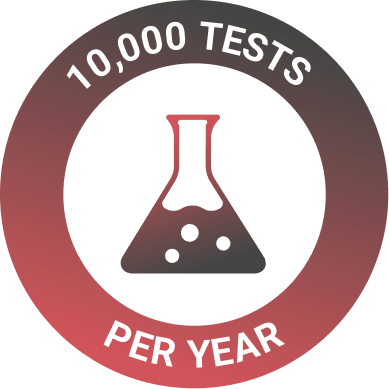Home >> Antibacterial >> ASTM E1153
ASTM E1153: 2014 – Standard Test Method for Efficacy of Sanitizers Recommended for Inanimate, Hard, Non-porous, and Non-food Contact Surfaces
ASTM E1153 is a standard test method approved by the EPA for determining the antimicrobial effectiveness of sanitizers intended for use on inanimate, precleaned, hard, nonporous, and non-food contact surfaces. This quantitative research method assesses the antimicrobial efficacy of products by quantifying the percent reduction of test microbes. The method is capable of monitoring short contact times, up to 15 seconds.
Test Organisms
Organisms typically used in this method: Staphylococcus aureus (ATCC 6538P), Klebsiella pneumoniae (ATCC 4352), Escherichia coli (ATCC 8739), Pseudomonas aeruginosa (ATCC 15442), Enterococcus hirae (ATCC 10541), MRSA (ATCC 33591), Salmonella entercia (ATCC 10708), Candida Albicans (MTCC 3017)
ASTM E1153 Test Method
- Microbial culture is inoculated on test surfaces and is left to dry out. 5 test carriers are required for ASTM E1153 testing.
- Product samples are added on to pre-inoculated test surfaces for specific contact periods.
- After the contact time, test surfaces are transferred into a neutralizing solution.
- Aliquots of neutralized suspension are used for the enumeration of viable microorganisms by plate count method.
- Microbial counts on test surfaces are compared with control (initial bacterial concentrations) which are run in parallel.
Benefits of ASTM E1153
Ensures public health and safety
The standard promotes safer environments by creating a framework to measure sanitizer efficacy, essential for hospitals, schools, offices, and public places to minimize the spread of diseases.
Supports product development and improvement
This test method serves as an important tool during product development by aiding manufacturers in optimizing their formulations to achieve higher efficacy rates.
Facilitates regulatory compliance
Compliance with this standard enables manufacturers to secure regulatory approvals quickly and consequently reduce time to market.
Enhances market competitiveness
Certification based on this test increases product credibility and consumer trust, providing a competitive edge.
Serves as a basis for quality control
Standard testing helps manufacturers identify performance variations thus ensuring uniformity in product quality.
Encourages innovation in antimicrobial technologies
High testing demands drive the development of advanced antimicrobial formulations.
Reduces environmental impact
Effective products which meet the standard requirements minimize chemical usage and environmental impact.
At MIS, our microbiology team professionals have extensive experience and expertise in designing ASTM E1153 protocol. Through our testing analysis services, our constant focus is on accuracy, precision, and quick turnaround times. MIS also offers ASTM E1053 test to help clients assess virucidal efficacy of chemical disinfectants used on inanimate and non-porous surfaces.
To get a quotation on ASTM protocols for disinfectant efficacy testing, contact our experts now and get thorough consultation.



FAQs
ASTM E1153 is a quantitative antimicrobial efficacy test method designed to evaluate sanitizer formulations for inanimate, hard, nonporous, non-food contact surfaces.
The test takes 1-2 weeks to complete.
At Microbe Investigations, we use the following bacterial and fungal strains: Pseudomonas aeruginosa (ATCC 15442), Escherichia coli (ATCC 8739), Staphylococcus aureus (ATCC 6538P), Enterococcus hirae (ATCC 10541), Klebsiella pneumoniae (ATCC 4352), MRSA (ATCC 33591), Salmonella enterica (ATCC 10708), Aspergillus niger (ATCC-16888), Candida albicans (MTCC 3017).
This test provides a standardized method to evaluate sanitizer efficacy on non-food contact surfaces, ensuring effective microbial reduction.
Products tested include chemical sanitizers and one-step cleaner-sanitizer formulations intended for use on lightly soiled, inanimate, hard, nonporous, non-food contact surfaces.
This test is designed for nonporous surfaces such as borosilicate glass, glazed glass, and stainless steel. Appropriate modifications may be required when evaluating spray-based or towelette-based antimicrobial products or other test surfaces not described in the method.
To pass this test, a product must demonstrate a minimum of 3 log reduction in test organisms on treated samples compared to untreated samples (control), which typically indicates 99.9% efficacy.
The sanitizer’s efficacy is determined by comparing the number of microorganisms recovered from treated carriers to control carriers and calculating the log reduction in microbial growth. The results are reported in terms of the log reduction which corresponds to the percentage reduction in microbial load.
The frequency of testing is not specified in the standard and may depend on regulatory requirements, product development cycles and quality assurance protocols. Typically, products are tested during development, after formulation changes, and periodically to ensure continued efficacy.
Some of the challenges associated with this test method include maintaining consistent test conditions, ensuring accurate and reproducible results, and managing potential contamination. Additionally, modifications may be needed for testing different types of products or surfaces which can complicate the procedure.
The test contributes to product quality and safety by providing a reliable method to verify the antimicrobial efficacy of sanitizers. This ensures that products are effective in reducing microbial contamination on non-food contact surfaces, thereby protecting public health and maintaining high standards of hygiene.
This standard is recognized by several regulatory bodies across the world which set standards for testing the efficacy of sanitizers.
Contact us for more information
Explore Other Tests
ASTME2149 | AATCC-100 | JISZ2801 | JISL1902 | EN 1276 | ISO 22196 | ISO 20743 | ISO 846 | ASTM E2180 | AATCC 147 | ASTM D7907-14 | ASTM E3031 | ASTM G29 | EN 16615 | EN 13697 | PAS 2424 | EN 1040 | EN 14349 | EN 13727 | EN 14561 | ASTM G22 | ASTM E1153 | ASTM D2574 | AATCC 174



